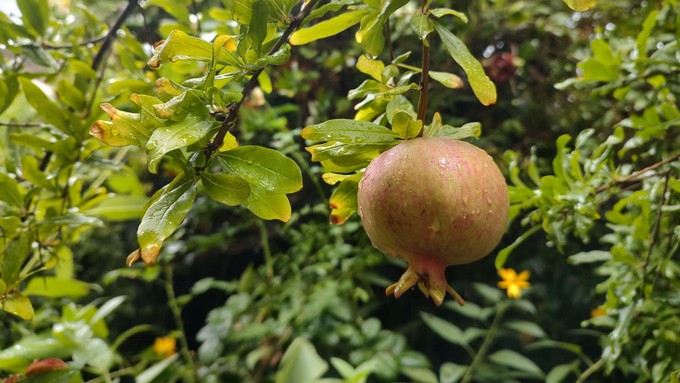
Fall starts Thursday after summer ended with a splash

Raindrops cover a ripening pomegranate as the tree's foliage begins to show its autumn color. Debbie Arrington
Who would have guessed? Our weird water year is coming to a soggy close.
Thursday (Sept. 22) marks the first day of fall, the start of a new season but the wrap-up of our water year – 12 months of seasonal moisture.
After the driest spring in Sacramento history and a bone-dry summer, Sacramento may actually have nearly normal totals for our 2021-22 water year, which ends Sept. 30.
Summer departed with an unexpected splash as thunderstorms rolled over the region. Including Monday’s downpours, Sacramento has collected 17.55 inches since Oct. 1, 2021. That’s 97% of average (18.14 inches) for a Sacramento water year.
That total is deceiving: Most of this water year’s moisture fell last October and December. Other than major rain events in those two months, storm systems have been sporadic at best. That’s left soil (and plant life) extremely dry.
So even though the overall numbers don’t look so bad, we’re still in a drought.
Our unusual September storm system delivered a lot of rain to some parts of the Sacramento region but hardly a trickle in others.
“The hit or miss nature of these storms means some areas saw a lot of rain and others didn't see much at all,” says the Sacramento office of the National Weather Service.
On Monday, Sacramento International Airport received 1.01 inches while Downtown Sacramento received only 0.37. Davis recorded 2.95 inches while Stockton rainfall measured just 0.07 inches.
Normal for our region for the first two weeks on September: 0.06 inches.
Tuesday and Wednesday, more spotty storms soaked some areas while skirting others. Rain totals differed from one neighborhood to the next. (My own backyard rain gauge in Sacramento’s Pocket neighborhood measures more than 2 inches from this week.)
How can you tell if your landscape got enough water?
Check soil with a moisture meter to see if your ground soaked up some of that free water. Or just look – and feel. Take a 6-inch trowel and dig; does the soil look dark and moist a few inches below the surface? If soil won’t clump in your hand, it needs more water.
Areas under protection – from big evergreen trees or structures – may have gotten less moisture from these storms. Check those spots, too.
If your landscape got a good soaking, take advantage of this storm and give your sprinklers a break. Turn off your irrigation system. For every inch of rain, wait a week to irrigate.
For more on local weather and rain totals:
Comments
0 comments have been posted.Sacramento Digs Gardening to your inbox.
Sites We Like
Garden Checklist for week of July 21
Your garden needs you!
* Keep your vegetable garden watered, mulched and weeded. Water before 8 a.m. to reduce the chance of fungal infection and to conserve moisture.
* Feed vegetable plants bone meal, rock phosphate or other fertilizers high in phosphate to stimulate more blooms and fruiting. (But wait until daily high temperatures drop out of the 100s.)
* Don’t let tomatoes wilt or dry out completely. Give tomatoes a deep watering two to three times a week.
* Harvest vegetables promptly to encourage plants to produce more. Squash especially tends to grow rapidly in hot weather. Keep an eye on zucchini.
* Pinch back chrysanthemums for bushy plants and more flowers in September.
* Remove spent flowers from roses, daylilies and other bloomers as they finish flowering.
* Pinch off blooms from basil so the plant will grow more leaves.
* Cut back lavender after flowering to promote a second bloom.
* It's not too late to add a splash of color. Plant petunias, snapdragons, zinnias and marigolds.
* From seed, plant corn, pumpkins, radishes, winter squash and sunflowers.